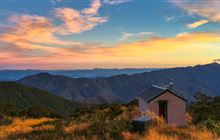About DOC huts
Introduction
Discover what facilities you can and can't expect to find in DOC-managed backcountry huts, and read the hut users code.Backcountry huts are more basic than backpacker hostels. They don't have showers, hot water, cooking and eating utensils or bed linen. You can't buy food or equipment.
Facilities
Huts have:
- bunks which are often sleeping platforms that allow a width of 75 centimetres per person
- toilets are usually long drop or composting (not flush)
- candle holders are provided at most huts where lighting is not provided
- where heating is provided, fuel is either gas or wood and available at some huts in peak season. An axe or saw are often provided at huts with wood heaters
- water is often supplied from a rainwater or streams. The water borne parasite Giardia may be present. Boil water for 3 minutes before use if you are unsure of the quality
- intentions (hut user) book is provided in huts. Always fill it in, as it may assist in search and rescue operations and also assists the Department to know how often a hut is used
- meat safes and/or dog kennels away from the hut, at some huts popular with hunters
- broom, brush and pan are provided to keep huts clean and tidy
Huts don't have:
- any food, cooking utensils, pots, pans - take your own
- sheets or blankets - take a sleeping bag
- rubbish collection - take all your rubbish with you
- showers
- toilet paper - take your own.
Services
Huts on Great Walks tracks often have wardens in the peak summer season. Wardens will check that visitors have the appropriate hut passes or tickets, provide information about track conditions, side trips and safety, supply weather forecasts (where they have a radio) and help ensure that huts stay clean and tidy. They may also provide interpretation of natural, cultural or historic values of places. Wardens also visit Serviced and Standard category huts on a regular basis.
Firewood is supplied at some serviced and Great Walk huts. However, only use as much wood as is needed to warm the hut. As wood needs to be flown in by helicopter, using it sparingly reduces carbon emissions and also ensures there will be enough for the next visitors. If firewood is not supplied and instead must be collected from the forest, some dead wood needs to be left in the bush for soil and forest health.
Huts may be actively managed for their historic values. This means the original fabric, design and character of the hut may not have changed much since it was built, and some standard services may be different. Interpretation about historic values may be provided.
Hut users code
- Keep huts clean and tidy. A broom, brush and pan are provided—use them, and leave muddy boots outside.
- Conserve gas when using gas heaters and cookers. During cooking always open a window or door to allow dangerous carbon monoxide fumes to escape. Keep an eye on boiling water/food, and be sure to turn gas heaters off overnight and make sure it is properly off when you leave.
- Take care using wood burners, keep the fire contained and never leave it unattended. Only burn dead dry wood and be careful with hot ashes. Make sure the fire is extinguished before leaving. Use wood sparingly and replace any you use for the next visitors.
- Share huts with others by being considerate, make room for late comers and keep quiet if others are sleeping. Share boiled water with other trampers to help conserve gas.
- Carry it in, carry it out – recycle ALL your rubbish. Take two bags, one for recycling and the other for rubbish/food scraps to carry out with you and dispose of responsibly.
- No smoking in huts, take your cigarette butts out with the rest of your rubbish.
- Hunters must follow the Firearms and Safety Code.
- No dogs allowed inside huts.
- Before leaving, close doors and windows securely.
- Always pay hut fees.



